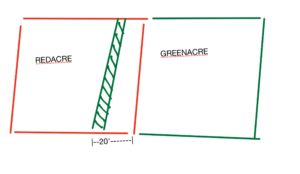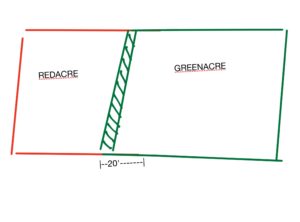This article illustrates the importance of seller disclosures in residential real estate transactions. Read the article here.
Adverse Possession
The doctrine of adverse possession can be found in the Code of Hammurabi, written around 2000 B.C.E. The doctrine was also observed by the ancient Romans. American property law (inherited from the British) recognizes the idea that one property owner can take title to land belonging to someone else. Adverse possession claims frequently arise in community associations. For example, suppose an owner’s lot is adjacent to common property, and over the years the owner gradually builds a flower bed, installs a play structure, and mows the grass several times throughout the year. If this continues for 10 years, the owner may claim adverse possession and take title to part of the common property.
Suppose there are two adjacent parcels. We’ll call them “Redacre” and “Greenacre”:
Now, suppose the owner of Greenacre decides to built a fence. But when the fence is constructed, it’s on Redacre’s property:
After a period of 10 years (and assuming the requirements of adverse possession are met), the owner of Greenacre may take title and ownership of the 20’ strip of land:
In order to establish a claim for adverse possession, the claimant must prove that the use is:
- Open and Notorious
- Exclusive
- Hostile
- Continuous
Open and notorious means that the claimant has left no doubt in the mind of the true owner of the potential adverse possession claim. The type of use or occupation must be consistent with the nature of the land. For example, planting trees on property that already has shrubs, bushes, and trees, is not open or notorious. That wouldn’t be an obvious adverse use. Limited use of property isn’t open or notorious, either. Occassional hiking or hunting on someone else's land doesn’t meet the requirement.
The next element is exclusive use. This doesn’t mean the claimant must use or occupy the property on a daily basis. Exclusive possession only requires occupancy that is characteristic of exclusive ownership. Building a fence is almost always considered exclusive use. But cattle occasionally breaking through a neighbor’s fence and grazing is not considered exclusive use. Cattle frequently wander onto adjacent parcels of land.
Things get tricky when it comes to proving the “hostile” requirement. Whether possession or use is hostile depends on the mindset of the claimant. In most cases, a mistaken belief of land ownership constitutes hostile. Suppose I purchase property and wrongly assume that my boundary line is 50 feet beyond the true boundary line. I then build a shed within the 50’, all the while believing it’s my land. That mistaken belief satisfies the hostile requirement.
Lastly, my adverse use or possession must be continuous. In most states, continuous means a period of at least 10 years. However, claimants may take advantage of “tacking”. Let’s say John builds a fence on the neighbors property and has satisfied all of the other requirements of adverse possession. After 3 years, John sells to Jill, who after only 1 year, sells to Jack. Using “tacking”, Jack may use the previous 4 years of ownership by John and Jill to meet the 10 year requirement.
Getting title through adverse possession isn’t as simple as declaring you’ve met all the requirements. Title is granted by a court through lawsuit to “quiet title.” In other words, the claimant must prove to a judge that each and every element of adverse possession has been satisfied.
For property owners who think they may be subject to an adverse possession claim, there are couple of options—all of which must be exercised before the 10 year period. First, the true owner may file a claim for trespass. If I notice my neighbor building a fence on my property, they are technically trespassers. Similarly, the true owner may preemptively file a suit to quiet title.
Real Estate Contract Checklist
Real estate contracts can be complicated documents. Here's a checklist to make sure the necessary terms and conditions are covered in the contract.
- Date
- Seller Information
- Buyer Information
- Real Property Legal Description (not just address)
- Personal Property Included or Excluded
- Title to Convey
- Title Exceptions
- Purchase Price
- Down Payment
- Interest Rate
- Installment Periods
- Date of First and Last Installment
- Late Charge
- Prepayment Penalty
- Portion of Purchase Price to Allocate Toward Personal vs. Real Property
- Prior Encumbrances
- Insurance Requirements
- Zoning of Property
- Exhibits
- Possession Dates
- Default Provisions





